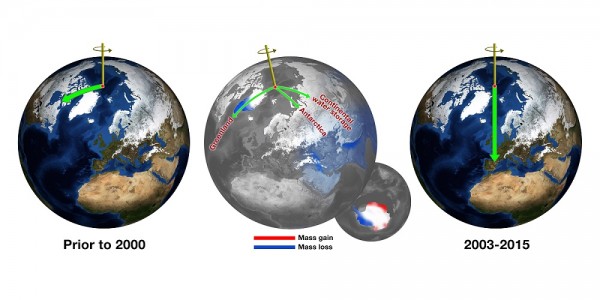By Ana Verayo, | April 10, 2016

Before about 2000, Earth's spin axis was drifting toward Canada (green arrow, left globe). JPL scientists calculated the effect of changes in water mass in different regions (center globe) in pulling the direction of drift eastward and speeding the rate (
Scientists are now saying that drought caused by global warming and climate change is now making Earth wobble on its own axis. In this new study, scientists say that the axial spin of the planet can become unstable however, reasons were unknown until now.
Like Us on Facebook
Now, researchers from NASA's Jet Propulsion Laboratory in California believe that drought along with prolonged periods of heavy rain around different regions of the planet are now causing Earth to wobble in space.
According to co-author of the study, Surendra Adhikari from NASA's Jet Propulsion Laboratory in Pasadena, the world is going through a massive global scale climate change in such a degree that, this change in climate is strong enough to affect the rotation of a planet. Adhikari adds that since 2000, the axis of the planet has shifted drastically towards the east by an average of seven inches every year, which is a massive swing.
There is also another pattern of axis wobbling that occurs every six to 14 years that has been an enigma for scientists for more than 100 years, in which researchers have examined in this new study.
Studying the Earth's movements on its axis is crucial for investigating these shifts, as they also affect the positioning and performance of satellites and GPS. Adhikari also says that the polar axis is also a powerful tool in indicating the effects of climate change.
Past and recent studies reveal how the melting and formation of the polar ice sheets around the globe have dramatically changed the distribution of mass around the planet, causing enough force to shift the entire polar axis.
Adhikari confirms this as these new findings show how the Greenland and Antarctic ice sheets are major driving forces that pushes and pulls the polar axis. Researchers from the NASA's Jet Propulsion Laboratory have charted the maximum impact of these types of changes in ice melt and loss, revealing their effects on the movement of Earth's axis and also determined how there might be some other forces at work.
By examining data obtained from NASA's GRACE (Gravity Recovery and Climate Experiment) satellite, the team found out that the changes of the amount of water on land masses corresponds to these shifts of the axis. When ice piles up on a region, it adds mass to this area including the accumulation of water in lakes, reservoirs or aquifers underneath the Earth's crust, pushing the axis away from this specific region.
This new study is published in the journal, Science Advances.
-
Use of Coronavirus Pandemic Drones Raises Privacy Concerns: Drones Spread Fear, Local Officials Say

-
Coronavirus Hampers The Delivery Of Lockheed Martin F-35 Stealth Fighters For 2020

-
Instagram Speeds Up Plans to Add Account Memorialization Feature Due to COVID-19 Deaths

-
NASA: Perseverance Plans to Bring 'Mars Rock' to Earth in 2031

-
600 Dead And 3,000 In The Hospital as Iranians Believed Drinking High-Concentrations of Alcohol Can Cure The Coronavirus

-
600 Dead And 3,000 In The Hospital as Iranians Believed Drinking High-Concentrations of Alcohol Can Cure The Coronavirus

-
COVID-19: Doctors, Nurses Use Virtual Reality to Learn New Skills in Treating Coronavirus Patients







